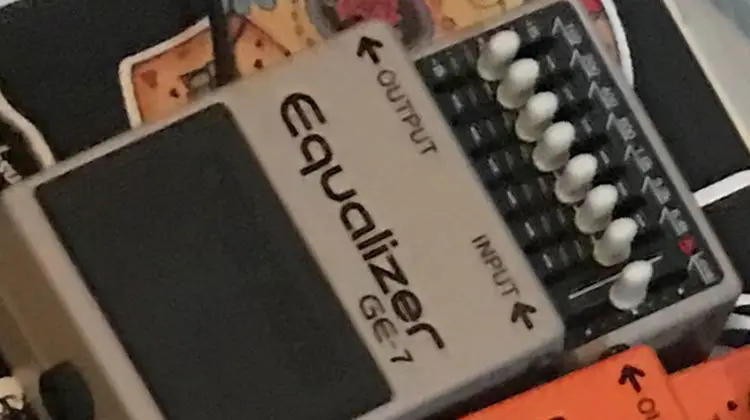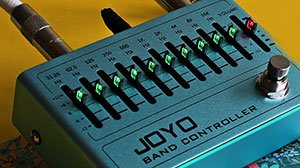Are you wondering what does an EQ Pedal do, and how does it work? Fortunately, you’ve come to the right place. We will aim to discuss the ins and outs of the function of the EQ pedal and how it works. Read on to learn more about this exciting pedal in greater detail, as well as some guitarists use them.

Have you ever been in a situation where, no matter how many adjustments and tweaks you made on your amp and any pedals you might be using, you still can’t find a tone that will make you happy? As if the guitar tone is close to your liking but just lacking, and you can’t quite put your finger on? An EQ pedal can likely help you in this situation.
Most music fans will probably never notice if an EQ pedal is on. Equalizer pedals aren’t the most glamorous pedal ever invented, and will likely will never be praised for creating iconic sounds. However, the importance of the equalizer pedal and its utility cannot be overstated. Many guitarists consider the equalizer pedal to be the secret weapon of their rig.
What Does an EQ Pedal Do?
An EQ pedal is a pedal with a graphic interface to adjust specific frequencies in your guitar signal. A guitar tone has unique characteristics that can change with pedals, amplifiers, or a completely different room altogether.
An EQ pedal allows you to shape the tone of your guitar as needed and provides a stable, consistent tone no matter where you might be. Equalizer pedals can also serve as a clean boost depending on how the guitarist utilizes the pedal.
How Does an EQ Pedal Work?
EQ pedals are relatively straightforward in terms of their application.
Guitars typically produce frequencies from 80 Hz to 1200 Hz, a reasonably wide range. Each guitar has a unique sound, shaped and morphed by amplifiers and guitar effects. However, there are instances where a guitar amplifier’s EQ will not suffice, and no matter how much adjustment is made, the guitar’s tone is still lacking.
EQ pedals are an effective band-aid, with a typical adjustment capability frequency range of 50 Hz to 6400 Hz. The pedal isolates certain regions of this frequency range and allows the guitarist to adjust the frequencies. Similar to a graphic equalizer EQ used on a car or home stereo.

Typical EQ Bands
The graphic interface of the EQ pedal features bandpass filters that adjust the specific frequency ranges attached to each interface slider. Commonly, EQ pedals will come in a different variety, featuring:
- A 10-band EQ interface, which allows the most control over individual frequencies
- A 7-band EQ
- A 5-band EQ
- A 3-band EQ, which has the least amount of control and is similar to the EQ settings found on an amplifier (Treble, Mid, Bass)
Control Tone
As you might have guessed, if you want the most control over the entire EQ of your guitar’s tone, you would likely opt for a 10-band EQ pedal, as each bandpass filter has a narrower focus of frequency range than those found on 3-band EQ’s. The choice you make depends entirely on what you feel is lacking in your tone and how much preference you wish to have over the nuance of your guitar’s sound.
Types of EQ Pedals
There are two types of EQ pedals available on the market. The first is a graphic EQ, in which the bandwidth of the central EQ cannot be adjusted. A great example of a graphic EQ can be found on an amplifier and tends to be the type more commonly found.
The second type of EQ pedal available is a parametric EQ, which functions similarly to the graphic EQ, except that bandwidths can be isolated for further adjustments. For this reason, parametric equalizer pedals tend to offer more tone customization.
Why Would You Want an EQ Pedal?
In addition to the ability to shape your tone, there are several different reasons you’ll want an equalizer pedal. One of the biggest reasons a guitarist might want an EQ is to consistently ensure that their guitar tone retains its tonal characteristics. Playing in different sized rooms can change the way a guitar sounds, and having an EQ can be beneficial in achieving a consistent tone for each performance.
EQ for Acoustic Guitar
An EQ pedal can also be helpful for acoustic players who experience feedback issues when playing live. An acoustic guitar often will have feedback due to stage monitors feeding the signal back into the guitar’s soundhole. An EQ pedal can effectively eliminate feedback by adjusting the appropriate bandpass filters. It can also help cut muddy-sounding frequencies and add a more crisp and accentuated attack.
EQ for Clean Boost
Another unique thing an EQ pedal can provide is a clean boost. EQ pedals can give a signal more volume like a boost pedal with the additional benefit of highlighting specific frequencies within the guitar signal according to taste.
EQ for Distortion
In addition to EQ shaping the tone of a guitar, it can be used to shape the EQ of a distortion or overdrive pedal, which can create a unique sounding crunch. For more information on this method, read on, as signal chain placement plays a big part in this method of use.
The Ideal Placement of the EQ Pedal in a Signal Chain
Pedal placement within a signal chain is essential, and every guitarist will likely have their unique pedal placement. For the most part, certain pedals tend to work better when placed in specific locations. The best EQ pedal location depends solely on how you wish to utilize the effect pedal.
EQ at the Beginning
When the EQ is placed at the very beginning of the signal path, the pedal functions to shape the guitar’s tone before any other pedals color it within the signal chain. This is especially useful when used with a distortion pedal, and you are looking to accentuate specific frequencies that the distortion pedal responds to. This can also be an excellent placement for a clean boost.
EQ After Distortion
Placing an EQ after a distortion pedal can effectively allow you to shape the tonal characteristics of the distortion effect itself. This can be very useful for creating a unique distorted flavor and ensuring that your distortion sounds the way that you wish. It can also boost the distortion and give more volume to the overall distortion in a clean boost manner (if the EQ bandpass filters are at a neutral setting).
A Helping Note of Function
If you are a guitarist that frequently performs live with a band, you should take great care to set up the bandpass filters of your EQ pedal in the musical setting in which you frequently perform. While you may likely find a great tone with the pedal while playing alone, the tone may sound different with your band. But do not worry, as this function is precisely what this pedal was made for.
Musical Genres Using EQ Pedals
Due to the inherent background function that the EQ pedal has, it is likely to be found in a wide variety of different musical genres. Guitarists of all playing styles could find a use for an EQ pedal as it can help to sonically shape the guitar’s sound for what a song needs. For the most part, EQ pedals have been used with metal, punk, pop music, hair metal, country, indie rock, and many more genres and subgenres that are too long to list.
Famous Guitarists that Use an EQ Pedal
Tom Bukovac
Tom Bukovac, one of the most famous and popular modern session musicians, has an outspoken love for his EQ pedal. His EQ pedal has been with him for a good duration of his career. He has recorded sessions for artists like Bob Seger, Vince Gill, Alison Krauss, Rob Thomas, Stevie Nicks, and more. He has playing credits on over 600 recorded songs.
Billie Joe Armstrong
Billie Joe Armstrong, the guitarist from the mega-famous pop-punk band Green Day, has an EQ pedal placed in the signal chain of his guitar pedals. He has the pedal placed inside a rack unit drawer, with the placement toward the beginning of his signal path.
Tim Pierce
Another famous session guitarist, Tim Pierce, is another renowned session player that often uses an EQ pedal in their rig. Tim Pierce has recorded for various artists and bands, including Phil Collins, Rita Coolidge, Bon Jovi, Rick Springfield, Meat Loaf, Kenny Loggins, and countless others.
Pete Loeffler
From the hard rock band Chevelle, Guitarist Pete Loeffler has an EQ pedal in his signal chain. He uses the EQ specifically for his dirty guitar channel and has the pedal placed after his overdrive to shape the tone of his distortion. Chevelle rose to prominence in the late 90s/early 2000s and typically only records with their gear on stage.
Mike Moreno
Jazz guitarist Mike Moreno also has an EQ placed in his signal chain. He uses a parametric 3-band EQ pedal placed behind his overdrive pedals to help shape the tone of his distorted tones. Mike Moreno has been making waves in the jazz world for the last decade or so, be sure to keep an eye out for him if you haven’t listened to his music.
Pete Thorn
Another famous session player, Pete Thorn, is known to use an EQ pedal in his rig for recordings. Pete Thorn has worked with Alicia Keys, Don Henley (of the Eagles), Jewel, and countless others. He currently has a YouTube channel that features reviews and gear demos, released frequently.
Conclusion
While it’s certainly not the most flashy guitar effect on the market, an EQ pedal can be a life-saving fix for tonal issues (especially those that you can’t place a finger on but know something is missing). No matter what style of music you play, an EQ pedal can shape your tone by filling in the missing gaps of your tone, shaping distortion, or giving your tone a unique sound akin to a filter.
Affordable Mainstay
An EQ pedal is perhaps one of the most important (and often overlooked) pedals that you could add to your signal chain. The best part is that EQ pedals can be extremely affordable. Take a chance and see if an EQ pedal can help some of the tonal issues you might be facing. It is a certainty that the equalizer pedal will be a mainstay effect in the guitarists’ arsenal for many years to come, no matter if they frequently perform live or record in the studio.
